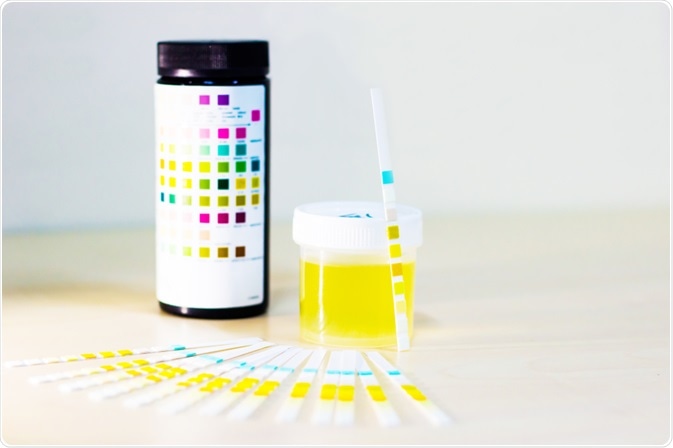Proteinuria is common in the adult population and its clinical significance can vary widely. A clear diagnostic process is needed to identify the cause of the findings and guide the treatment decisions.

Image Credit: Master the moment / Shutterstock.com
A dipstick test is often the first indicator of proteinuria. The extent of protein in the urine can be further investigated with a 24-hour urine collection test. If the results are positive, other diagnostic tests may be required to establish the cause of proteinuria and aid in the management of the condition. Referral to a nephrologist may also be needed in some cases.
Presenting symptoms
In most cases, mild to moderate proteinuria does not precipitate symptoms. In fact, many patients may be diagnosed with proteinuria following routine testing to evaluate the patient's general health or conditions such as hypertension or diabetes.
Some patients may notice that their urine is more frothy than usual. In more severe cases, proteinuria may be associated with edema, ascites, hydroceles, and pleural effusions.
Normal urinary protein excretion
Healthy adults usually excrete between 80 and 150 milligrams (mg) of protein in their urine each day, including serum globulins and albumin. This is quite low, as larger proteins are not able to pass through the glomerular membrane into the kidney. The majority of large proteins that are able to pass into the kidney are reabsorbed into the bloodstream through the proximal tubule.
However, in some cases, there may be an abnormality in the function of the glomerulus, proximal tubule, or production of proteins, all of which can lead to the presence of excess protein in the urine.
Clinical proteinuria is classified as 0.5 grams (g) of protein or more excreted in a 24-hour period or with an albumin:creatinine ratio of 30 mg/mmol or more.
Dipstick test
The urine dipstick test can be used as an initial indicator of the presence of protein in the urine and renal disease, as it is a simple and easy test to conduct. This test involves a single urine sample, which is immediately analyzed for the presence of certain substances, such as protein, blood, and albumin, that may be indicative of renal disease.
As many as 17% of the adult population will have positive findings from the dipstick test; however, less than 2% will have a condition that requires treatment.
Given the high rate of false positives, if mild to moderate proteinuria is detected with a dipstick test, the test may be repeated in 2-3 weeks to monitor the protein concentration. If severe proteinuria is detected, or a second test proves to be positive, further diagnostic testing is required.
Proteinuria: what is it, and what causes it?
Urine collection test
Proteinuria is usually diagnosed by measuring the quantity of protein in urinary excretion in a 24-hour period. This test involves the collection of all urine excreted over a complete day, which is then analyzed for the quantity of protein.
Although the testing period can begin at any time, most patients start in the morning. The bladder should be emptied completed at the beginning of the day with no sample taken. From that point, the urine should be collected in containers every time the individual needs to urinate. This continues until exactly 24-hours after the start time, which is when the final sample should be taken.
It is important that the urine samples are kept in a cool place, such as the refrigerator, until the conclusion of the collection period, which is when the should be sent to a laboratory for testing.
In otherwise healthy people, the excretion of more than 500-1000 mg of protein in a 24-hour period may be indicative of an abnormality in the function of the kidneys. This may warrant further investigation, such as a blood analysis or kidney biopsy. If more than 2 g of protein is excreted within 24 hours, the patient is likely to have a glomerular malfunction.
Protein:creatinine ratio
Proteinuria can also be diagnosed with a single urine sample by calculating the protein:creatinine ratio.
When the kidneys are functioning normally, they remove creatinine from the blood to keep the levels in the blood and urine in balance. The ratio of the protein to creatinine in the urine sample is a good indicator of the quantity of protein that is excreted in a 24-hour period and can, therefore, be used in the diagnostic process. An individual who excretes more than 30 mg of albumin for every g of creatinine is considered to have proteinuria.
References
Further Reading
Last Updated: May 20, 2021